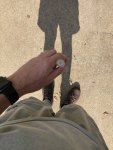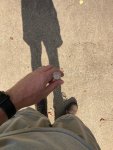- Jun 8, 2020
- 590
- Pool Size
- 14060
- Surface
- Plaster
- Chlorine
- Salt Water Generator
- SWG Type
- Pentair Intellichlor IC-40
I ordered a set of standard solutions from tftestkits on Aug 17th, and just today got around to trying out the 50ppm CYA solution, to make sure I'm testing my new pool accurately.
I dissolved enough CYA granules in my pool to achieve 20ppm (38oz for my 14,060 gal pool), and when I test the pool water, the dot disapears right at the 20ppm mark.
But when I test the standard solution, the dot isn't disappearing until I get above the 30 mark. I'm mixing 15ml of the standard R-7065 solution (or pool water) with 15ml of the R-13 Reagent solution. Mixing gently by rocking the bottle back and forth for 30 seconds, then pouring into the view tube while holding it waist high and sun to back.
Here are pictures of the 15ml/15ml mix, with the tube filled to the 50ppm mark. I've tried sun to back, sun to side, standing under patio shade, as well as standing under tree shade. In all cases, the dot is pretty visible with the 50ppm standard solution.
So I wondered if this is just what I should be looking for in my pool water test, and I'm actually well above 20ppm (don't know how though, since I used PoolMath to calculate how much to add), or if maybe the standard solution just has a short shelf life and I missed the window.
I searched TFP and found similar posts about this same issue, but never really saw any resolution other than folks giving up on the standard solution.
In this first picture, the dot is actually much more visible to the eye than it appears to the camera (probably due to iPhone camera functionality):
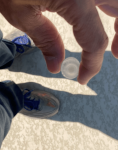
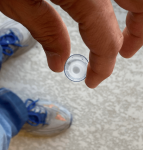
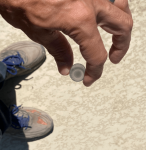
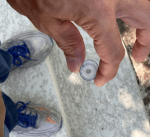
I dissolved enough CYA granules in my pool to achieve 20ppm (38oz for my 14,060 gal pool), and when I test the pool water, the dot disapears right at the 20ppm mark.
But when I test the standard solution, the dot isn't disappearing until I get above the 30 mark. I'm mixing 15ml of the standard R-7065 solution (or pool water) with 15ml of the R-13 Reagent solution. Mixing gently by rocking the bottle back and forth for 30 seconds, then pouring into the view tube while holding it waist high and sun to back.
Here are pictures of the 15ml/15ml mix, with the tube filled to the 50ppm mark. I've tried sun to back, sun to side, standing under patio shade, as well as standing under tree shade. In all cases, the dot is pretty visible with the 50ppm standard solution.
So I wondered if this is just what I should be looking for in my pool water test, and I'm actually well above 20ppm (don't know how though, since I used PoolMath to calculate how much to add), or if maybe the standard solution just has a short shelf life and I missed the window.
I searched TFP and found similar posts about this same issue, but never really saw any resolution other than folks giving up on the standard solution.
In this first picture, the dot is actually much more visible to the eye than it appears to the camera (probably due to iPhone camera functionality):








